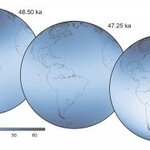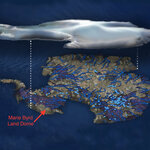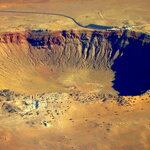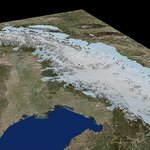Geology

Where does magma gather in the earth's crust? And for how long? With worldwide poverty in decline, plentiful food thanks to science, and life expectancies increasing each year, we can turn to more remote worries - and learn some new things in the process. Like about volcanic eruptions and magma.
After studying layers of pumice visible in road cuts and other outcrops in the Taupo Volcanic Zone of New Zealand, where some of the biggest eruptions of the last 2 million years occurred, and measuring the amount of crystals in the samples and using thermodynamic models, researchers have…

The Federal Court of Appeal decision that halted construction on the Trans Mountain Pipeline expansion has thrown Canada into a tizzy.
While British Columbia First Nations and environmentalists are celebrating a rare court victory on this project, industry representatives, trade unions and many other First Nations who supported the expansion feel the decision is a nightmarish intervention in plans that were many years in the making.
The court found major shortcomings in Canada’s consultation processes, but it has also delayed and maybe overturned what was perhaps the most extensive and…

The South Atlantic Anomaly has people concerned, but if Earth's magnetic field of the past is any indication, and it is, the anomaly is not a precursor of a switching of the poles.
What is the South Atlantic Anomaly?
Earth's magnetic field serves as a shield against hazardous radiation from space, like the Sun's charged particle flux. Since 1840, when systematic measurements began, the global strength of the magnetic field has decayed at a rate of about five percent per century. And a significant anomaly of reduced magnetic strength has appeared over the South Atlantic, which as been dubbed…

There is additional evidence a mantle plume, basically a geothermal heat source such as a volcano, is below Antarctica's Marie Byrd Land and it explains a substantial amount of the melting that creates lakes and rivers under the ice sheet.
Mantle plumes are thought to be narrow streams of hot rock rising through Earth's mantle and spreading out like a mushroom cap under the crust. The buoyancy of the material, some of it molten, causes the crust to bulge upward. The theory of mantle plumes was proposed in the 1970s to explain geothermal activity that occurs far from the boundary of a…
This is a good example of a story that has morphed and changed as it gets passed from one paper to another. They all cite the same source, from the BBC but the reporters haven’t read the source. I think they just read each other. The science is actually rather interesting. But just about everything they say is the opposite of what the original story says. And actually the original paper suggests trying this at Long Valley in California rather than Yellowstone.
This is the original story on the BBC:
Nasa’s ambitious plan to save Earth from a supervolcano
This is what Fox News make of it…

Satellite data have detected widespread water within ancient explosive volcanic deposits on the Moon. That means its interior may contain more indigenous water than previously believed. The ancient deposits are believed to consist of glass beads formed by the explosive eruption of magma coming from the deep lunar interior.
Lacking any way to know in the past, the assumption was that the interior of the Moon had been largely depleted of water and other volatile compounds. In 2008 researchers detected trace amounts of water in some of the volcanic glass beads brought back to Earth from the…

Here are some surprising facts about humans’ effect on planet Earth. We have made enough concrete to create an exact replica of Earth 2mm thick. We have produced enough plastic to wrap Earth in clingfilm. We are creating “technofossils”, a new term for congealed human-made materials – plastics and concretes – that will be around for tens of millions of years.
But it is the scale that humans have altered Earth’s life support system that is the most concerning.
In 2000, Nobel laureate Paul Crutzen and Eugene Stoermer proposed that human impact on the atmosphere, the oceans, the land and ice…

The Alps are steadily "growing" by about one to two millimeters per year. Likewise, the formerly glaciated subcontinents of North America and Scandinavia are also undergoing constant upward movement.
This is due to the fact that at the end of the Last Glacial Maximum (LGM) about 18,000 years ago the glaciers melted and with this the former heavy pressure on the Earth's surface diminished. The ice reacted rapidly to climate change at that time whereas the Earth's crust is still responding today to this relatively sudden melting of ice. During the LGM the Alps were also coated with an ice cap…

New research suggests that "flash droughts", like the one that unexpectedly gripped the Southern Rockies and Midwest in the summer of 2012, could be predicted months in advance using soil moisture and snowpack data.
Scientists at the National Center for Atmospheric Research (NCAR) analyzed the conditions leading up to the 2012 drought, which ultimately caused $30 billion in economic losses, looking for any warning signs that a drought was on the way. They find that observations of snowmelt and soil moisture could have predicted the ensuing drought up to four months in advance.
"The 2012…

By 1992, environmental activist Jeremy Rifkin claimed, we would achieve Peak Oil. Fossil fuels would begin to decline. Rifkin was just going by an environmental press release but Peak Oil had a long history; almost as long as oil itself.
In 1919, the chief geologist of the United States Geological Survey, said Peak Oil would happen within 3 years, while King Hubbert of Shell Oil predicted in 1956 that Peak Oil would happen by 1971. So by 1992 those claims were only working with a new generation of people who didn't understand science. In reality, math models containing all those variables are…